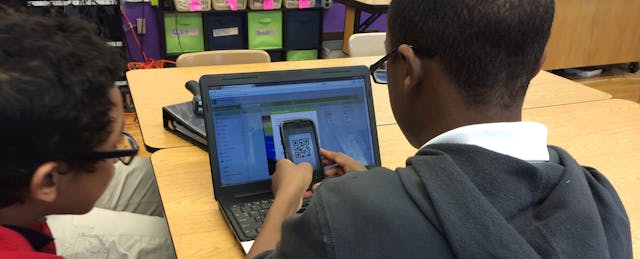If you searched for “Bailey Middle School” three years ago, the top result would be “Gun Found at School.” Today, you will find articles about the successes of our Bailey scholars in national magazines, education blogs, and on TV news reports. How did this happen in such a short time, at a school where 95% of students live in poverty? The answer lies in a combination of the right people embracing the right program.
Magnet School Assistance Program STEM Grant
With a grant from the Magnet Schools Assistance Program (MSAP) in 2011, our school became Bailey STEM Magnet Middle School, and received an influx of technology. We essentially became a 1:1 school with laptop carts in every classroom. We also have a science closet that made me drool the first time I saw it: Vernier technology (digital sensors and electronic scientific tools), microscopes, Lego Mindstorm Robotics Kits, and engineering and building materials galore!
The Right People
Having the money and materials is one thing, but having the right faculty and staff to use them effectively with students is another entirely. Our Principal, Dr. Christian Sawyer, was charged with “turning around” Bailey. Before the turnaround process began, Bailey was the lowest performing school in the entire state of Tennessee. Now, in our third year of turnaround, the stakes are high. Although we have jumped two levels from a Target school to a Satisfactory school by district standards in two years, if our test scores this year do not reflect the incredible work going on at our school, we will be shut down.
Dr. Sawyer, who was hired to lead our turnaround process immediately following the MSAP grant, done this by recruiting dynamic, passionate and dedicated faculty who embrace the STEM theme and use it to empower our scholars. He also implemented a revolutionary instructional leadership model which relies on teachers to make all major decisions. Additionally, we are responsible for hiring the teachers on our teams, mentoring new teachers, and providing small group intensive remedial or enrichment instruction. Instructional Leaders give teachers extra support for planning, data analysis, implementing technology and additional hands for instruction in the classroom.
At Bailey, we have dissolved the notion of “one teacher, one classroom,” leading to a fully integrated blended learning program in all subject areas, using adaptive technology to identify scholars’ deficits and catch them up to grade level. There are typically three days days a week when students rotate through classrooms attending small group instruction, computerized adaptive programs, and whole group core instruction. We use tools like Read 180, Manga High, and Brain Pop, and have also partnered with Republic Charter to offer three sections of Computer Science to our students.
Student Involvement
While we have metrics to show improvement at Bailey--including an 18% increase in science proficiency and 11% increase in math proficiency (outpacing the state average growth), a decrease in discipline incidents by 40%, and 90% of teachers reporting “Bailey is a good place to work”--the power of change can best be demonstrated through a personal anecdote.
This is the story of one scholar whom I will call Marquan. Marquan came to Bailey after spending time in alternative school. By the time he came to us, he was beaten down. He did not see a future for himself and had a difficult time getting along in school. He heard voices that told him he would never succeed. But that was all before he became involved in a STEM project at Bailey.
Marquan and a few other students entered a national STEM contest which posed the question, “How can you use your STEM skills to help your community?” The group chose to focus on energy conservation to reduce heating bills in the winter. They received donations to make energy conservation changes in their homes, conducted scientific experiments to prove the efficacy of those changes, and developed an app to predict savings based on Nashville’s electricity prices. They put their work together in a video submission for the contest. A few weeks later, they found out that they were one of 15 national finalists in the competition. They won a trip to Texas to present their research and received $35,000 in technology for our school. Marquan boarded a plane for the first time in his life, as a winner. Before this contest he had never received an award certificate in his life. Now he has been featured in Forbes magazine and other news sites. He says that STEM changed his life. He is now an A/B student with plans to attend college and focus on sound engineering.
This one success story changed the momentum of our entire school. Our STEM identity became stronger. Scholars are more interested in participating in STEM projects, in the hopes that they, too, will one day get to fly to Texas as a STEM champion. Last year we had 18 submissions for our district’s Project Based Learning Fair, winning gold, silver, and bronze medals.
We are on track to make our target test scores and keep doing our important work. But even if we miss the mark, there are scholars whose lives will forever be changed because of STEM and the teachers who brought it alive for them.


